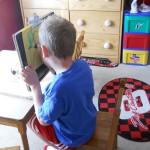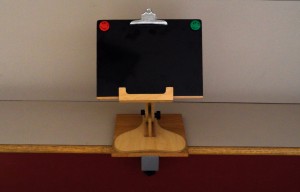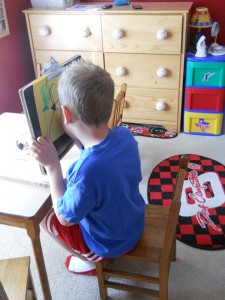Designers: Kailey Boyce and Ameeka George
Client Coordinator: Diana Garrett, COTA/L, Durham Public Schools
INTRODUCTION
Our client, Bob (pseudonym), is a young boy with septo-optic dysplasia, which is a visual impairment, and autism. He has decreased vision in both eyes and can only see in certain spots of his visual field. He therefore must move his head until the object of interest appears in one of those spots. His visual impairments most greatly affect his reading and writing; Bob is only able to read and write when his eyes are a few inches from the page. For example, to read a 26-point font, he needs to have his eyes only 2-3 inches from the page, and to read a smaller font, he must be at an eye-lash distance.
As a result, Bob must bend over his classroom desk to do all of his reading and writing activities. His teacher and occupational therapist were concerned that this would cause long term damage to his spine. Commercial devices, such as a slant board, are helpful but still do not position the materials at an appropriate location. We have developed a device that allows him to maintain an upright position at his desk while performing his classroom assignments. To accomplish this task, we have customized a portable Versa Table to fit his needs (figure 1).
[youtube]http://www.youtube.com/watch?v=mfxq71Y_clI[/youtube]
STATEMENT OF IMPACT
The View It Display Stand allows Bob to sit vertically while reading and writing. The device therefore prevents damage that would be caused to the client’s spine if he were to continue bending over his desk to perform his classroom activities. Also, according to the client’s teacher, this device helps Bob to stay focused in the classroom: “during your weekly visits, you are able to get him to do more work with your device than I get him to do in the entire rest of the day”.
TECHNICAL DESCRIPTION
The device is a work surface mounted to a supporting arm with adjustable positioning. The work surface is capable of holding books and papers while reading or writing. After being attached to a desk in front of the client, the work surface is positioned vertically at the appropriate distance. The distance is adjustable to allow Bob to see different font sizes or give him room to write. With this device, Bob is able to remain seated completely upright while accomplishing his classroom activities.
A. Base and Desk Attachment
The base of the device is a 12” by 12” piece of oak which is coated in a polyurethane finish and the commercial Versa Table is permanently attached to this base using construction glue. A clamp, which tightens by turning a star knob, secures the device to the client’s desk using a bolt with a rubber stopper. When the star knob is turned, the rubber stopper tightens against the underside of the desk and prevents the device from sliding. The clamp, which holds the bolt in place, is screwed into the in the bottom of the base. To make the device sit flat, the clamp was set into the wood by milling out a section of the oak. This ensured that the bottom of the clamp would be flush with the bottom of the oak base.
B. Adjustability
The position of the device is controlled by the tension of four bolts attached to separate plastic knobs. The bottom knobs control the height and front to back motion of the work surface, while the top knobs adjust its tilt. To position, just loosen the appropriate knob(s), adjust to the desired location, and re-tighten the knob(s). The angle of the work surface has a 90 degree range from completely vertical to completely horizontal. The horizontal position is useful for storage because the device is in its most compact state.
C. Work Surface
The work surface is a 12” x 16” piece of white birch veneer with a lacquer finish. Fastened to the surface’s front is a 12” x 16” magnetic dry erase board. The dry erase board is black to create a strong contrast between the background and Bob’s reading or writing materials. Since the white pages stand out against the black of the dry erase board, this helps Bob to focus on his assignments and makes it easier for him to see. The dry erase board can also be used as its own writing surface and is easy to clean, which is important because it will constantly be in contact with the client’s hands and face.
There are three methods of holding books or papers on the device. The first is by using magnets to hold papers to the magnetic dry erase board. The second is a clip board which is screwed into the top of the work surface and can be used for both books and papers. The third is a book holder which uses two vertical projections to keep books open and secure. The book holder is detachable so it can be out of the way while not in use. It slides on and off the work surface’s bottom ledge and the books are placed on the board behind the projections of the holder.
The total cost of this device is $255.




University Operator: (919) 962-2211 | © 2024 The University of North Carolina at Chapel Hill |